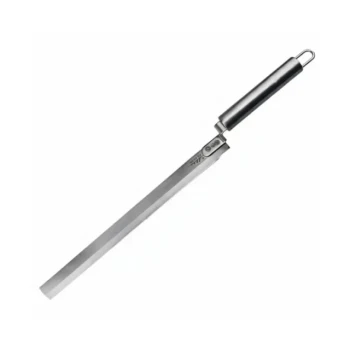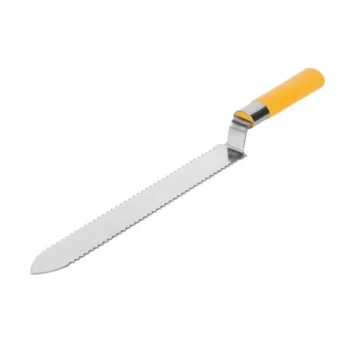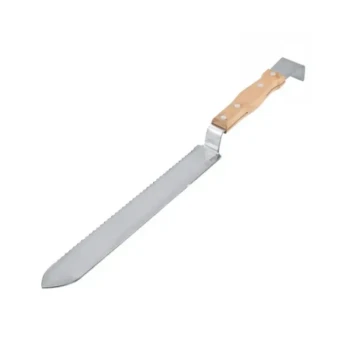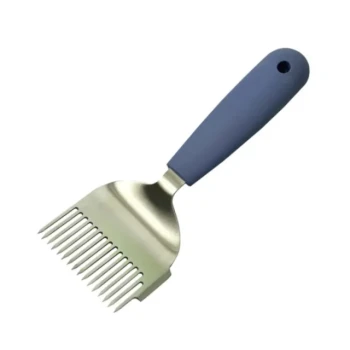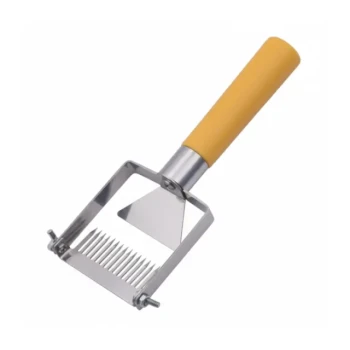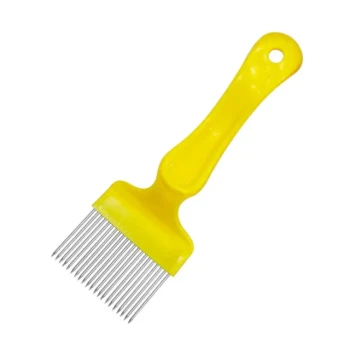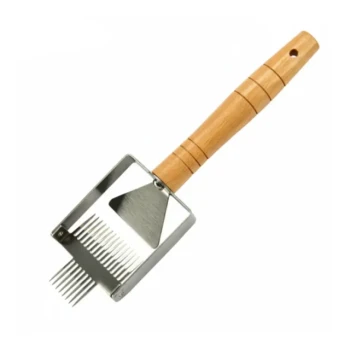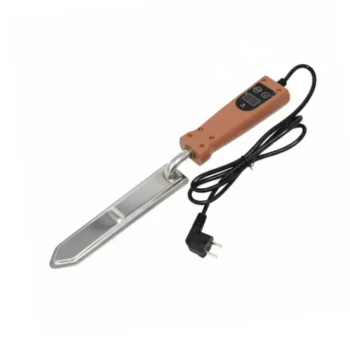At its core, a bee knife is a specialized tool used by beekeepers during the honey harvesting process. Its primary purpose is to cleanly slice off the thin layer of beeswax, known as "cappings," that bees build to seal honey inside the honeycomb cells. Removing these cappings is the essential first step to allow honey to flow out of the comb for extraction.
A "bee knife," more formally called an uncapping knife, is not a general-purpose hive tool for daily inspections. Instead, it is a dedicated instrument used specifically during the honey extraction phase to unseal the honeycomb.
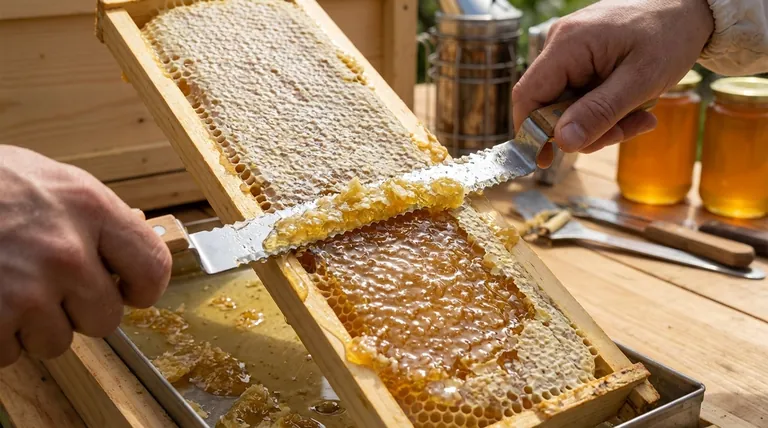
The Role of Uncapping in Honey Harvesting
To understand the knife's function, you must first understand why beekeepers need to "uncap" their honeycomb frames.
Why Uncapping is Necessary
Bees fill honeycomb cells with nectar and dehydrate it to create honey. Once the honey reaches the correct moisture content (around 18%), the bees seal the cell with a fresh wax cap. This cap protects the honey and keeps it from fermenting.
To harvest the honey, a beekeeper must first remove these protective wax cappings.
The Bee Knife's Specific Function
The uncapping knife is designed to slice off this top layer of wax efficiently. The long, thin blade allows a beekeeper to remove all the cappings from a frame in just a few smooth passes.
Many knives are heated (either electrically or by dipping in hot water) to melt through the wax, making the process faster and cleaner.
Ergonomic and Safety Design
A common feature is an offset or "Z-shaped" handle, as noted in beekeeping guides. This design keeps your knuckles up and away from the sticky frame, preventing you from getting covered in honey and providing better leverage for a clean cut.
Types of Uncapping Knives
While the goal is the same, uncapping knives come in a few variations, each suited for different preferences and scales of operation.
Serrated vs. Straight Edge
Serrated knives are excellent "cold" knives, meaning they don't require heating. The serrations act like a saw, cutting through the wax caps effectively. They are particularly useful for cutting through tougher comb or honey that has begun to crystallize.
Straight-edged knives are most effective when heated, allowing them to glide through the wax like a hot knife through butter.
Electric vs. Manual Knives
Manual knives are simple blades that are either used cold or heated in a pot of hot water. Electric knives have a built-in heating element with a thermostat, providing a consistent temperature for effortless and rapid uncapping.
Understanding the Trade-offs and Alternatives
While a knife is a common tool, it is not the only option, and it's not listed among the absolute basic tools for simply managing a hive.
The Learning Curve
Using an uncapping knife effectively requires some practice. An unskilled hand can cut too deeply, removing excessive amounts of honey with the cappings and potentially damaging the structural integrity of the honeycomb.
Alternative Uncapping Tools
Many beekeepers, especially hobbyists, prefer other tools. An uncapping fork (or scratcher) has sharp tines used to puncture and lift the cappings. A spiked roller is another option that perforates the cappings as you roll it across the frame.
When a Knife Is the Best Choice
For beekeepers with many hives, an electric uncapping knife is unmatched for speed and efficiency. It allows for processing a large number of frames quickly, which is critical in a large-scale harvesting operation.
Making the Right Choice for Your Goal
The right tool depends entirely on the scale of your beekeeping operation and your personal preference.
- If your primary focus is a few hobby hives: An inexpensive uncapping fork or scratcher is often the simplest and most cost-effective solution.
- If your primary focus is harvesting honey from multiple hives efficiently: An electric heated uncapping knife is a worthwhile investment that will save you significant time and effort.
- If your primary focus is minimizing waste and mess: A heated knife, used skillfully, produces clean cuts and leaves cappings that are easy to render into a block of beeswax.
Choosing the right instrument is about matching the tool to the specific task of honey extraction.
Summary Table:
| Feature | Description |
|---|---|
| Primary Use | Slicing off wax cappings to unseal honeycomb for extraction. |
| Common Types | Electric Heated, Manual (Straight/Serrated edge). |
| Best For | Beekeepers harvesting from multiple hives; prioritizes speed and efficiency. |
| Key Benefit | Allows for rapid, clean uncapping of frames, especially with heated blades. |
Ready to Optimize Your Honey Harvesting Process?
As a commercial beekeeper or equipment distributor, efficiency is paramount. The right uncapping knife can drastically reduce your labor time and increase your yield. HONESTBEE supplies professional-grade beekeeping supplies and equipment, including high-efficiency uncapping knives, designed specifically for the demands of commercial apiaries and wholesalers.
Contact our expert team today to discuss how our wholesale-focused solutions can enhance your operation's productivity and profitability.
Visual Guide
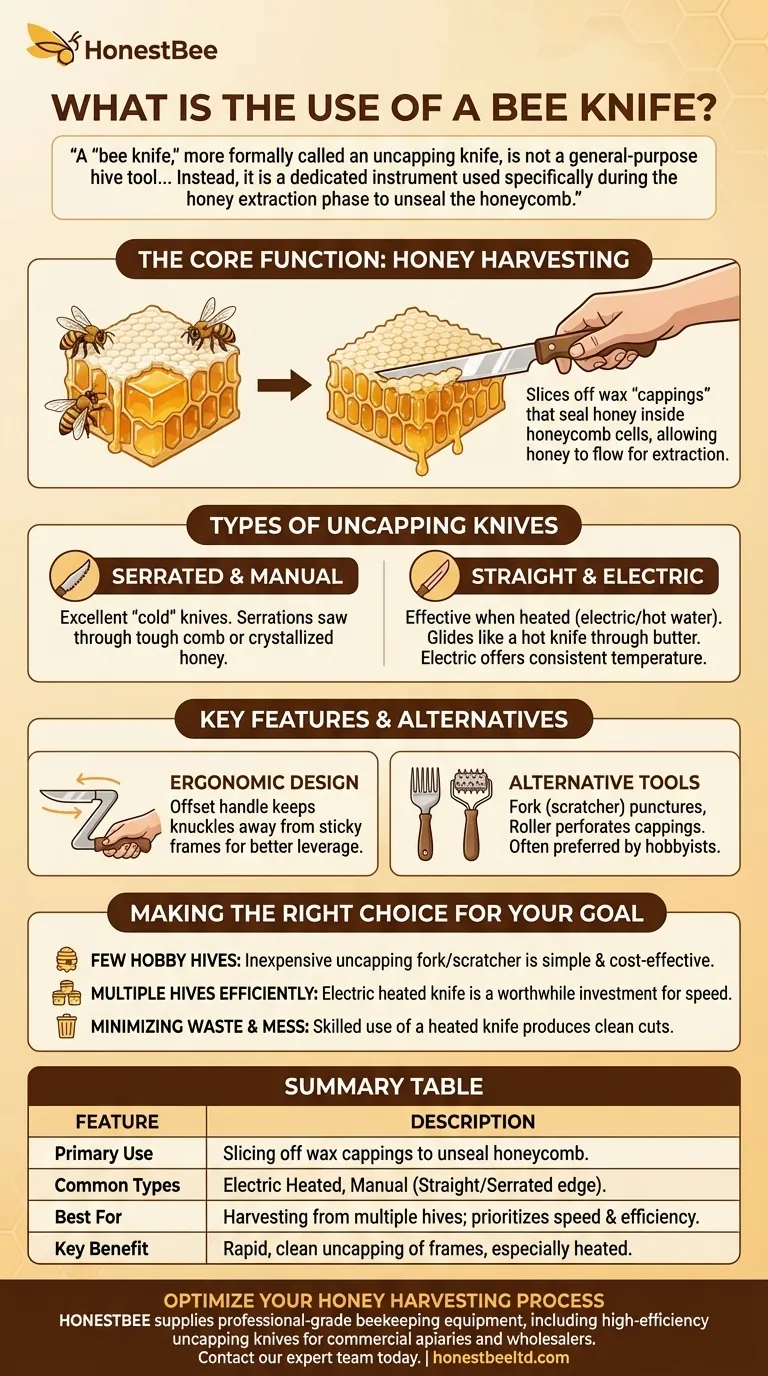
Related Products
- Serrated Honey Uncapping Knife for Beekeeping and Bee Hive Maintenance
- Electric Heated Honey Uncapping Knife for Beekeeping
- Honeycomb Uncapping Knife for Apiculture
- Professional All-Stainless Steel Uncapping Knife for Beekeeping
- Extra-Wide All-Stainless Steel Honey Uncapping Fork with T-Handle
People Also Ask
- How to clean an uncapping knife? Master the Hot-Knife Method for Easy Maintenance
- How are honey frames prepared before extraction? Master the Hive-to-Honey-House Process
- What is the benefit of the serrated edge on an uncapping knife? Unlock Faster, Cleaner Honey Extraction
- What is a Decapping Knife and what is its purpose? Achieve a Smooth & Efficient Honey Harvest
- What is the use of an uncapping knife? Master the First Step of Honey Harvesting



